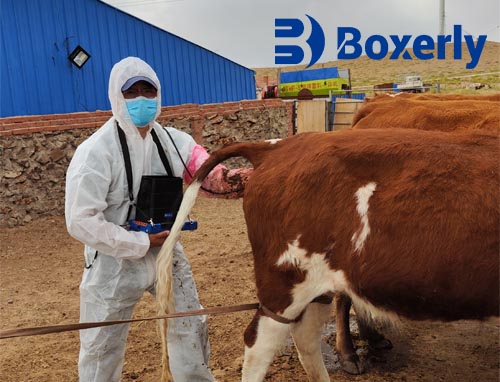In the world of livestock farming, ensuring the health and productivity of cows is vital to both dairy and beef operations. One of the most valuable tools available for veterinary professionals is BXL bovine Veterinary ultrasound. This advanced imaging technology offers non-invasive, real-time insights into the health of cattle, enabling veterinarians to diagnose a wide range of conditions early and efficiently. From pregnancy monitoring and reproductive health to internal organ assessment and injury detection, BXL bovine veterinary ultrasound plays an essential role in improving herd health and optimizing farm management. In this article, we’ll explore what BXL bovine ultrasound is, how it works, its applications, and why it’s an essential tool for modern cattle care.
What is BXL Bovine Veterinary Ultrasound?
BXL bovine veterinary ultrasound refers to a specialized ultrasound system designed to provide detailed, real-time imaging of cattle’s internal structures. The technology uses high-frequency sound waves to produce images of the internal organs, reproductive systems, muscles, and other soft tissues, helping veterinarians diagnose a variety of conditions without the need for invasive procedures.
BXL ultrasound systems are specifically designed to meet the needs of veterinary professionals working with cattle. These systems are known for their precision, ease of use, and high resolution, making them ideal for diagnosing conditions in both dairy and beef cattle. Whether it's checking for pregnancy, evaluating reproductive health, or monitoring the internal health of cows, BXL ultrasound offers accurate, actionable insights.
How Does BXL Bovine Veterinary Ultrasound Work?
BXL bovine veterinary ultrasound works by sending sound waves through the cow's body using a handheld probe. These sound waves are reflected back by internal structures, and the ultrasound machine processes these echoes to create images of the internal organs or tissues. The resulting image is displayed on a monitor, allowing the veterinarian to evaluate the health and condition of the animal.
Types of Ultrasound Probes for Cattle
BXL ultrasound systems come equipped with several types of probes designed for different purposes:
- Linear Probe: Used for imaging superficial structures, such as the udder, tendons, and joints.
- Convex Probe: Ideal for deeper imaging, such as monitoring reproductive organs, abdominal organs, or checking for internal injuries.
- Endocavity Probe: Inserted into the rectum or vagina to assess the reproductive organs, including pregnancy status, uterine health, and fetal development.
The Imaging Process
To perform a BXL ultrasound exam on a cow, the veterinarian applies a layer of gel to the area being scanned (typically on the abdomen or rectum) to ensure proper conduction of sound waves. The probe is then moved across the skin or inserted for internal imaging, providing real-time images of the cow’s internal structures.
Applications of BXL Bovine Veterinary Ultrasound
1. Pregnancy Diagnosis and Monitoring
One of the most common uses of BXL bovine veterinary ultrasound is to confirm pregnancy in cows. Early pregnancy detection is crucial for efficient herd management, as it allows farmers to plan for calving and manage the nutritional needs of pregnant cows. Ultrasound can detect pregnancy as early as 28-30 days after breeding, providing an accurate alternative to palpation methods.
- Early Detection: Detecting pregnancy early allows for better management of feeding, calving schedules, and herd rotation.
- Fetal Health Monitoring: Regular ultrasound exams can track fetal development, ensuring the calf is growing properly and detecting any complications, such as abnormal positioning or the presence of twins.
- Twins Detection: Ultrasound helps detect multiple pregnancies, which is critical for managing the risks associated with twin calvings, such as dystocia (difficult calving) and preterm birth.
2. Reproductive Health and Fertility
Monitoring reproductive health is essential to maintaining a high level of fertility and reproductive efficiency in a herd. BXL ultrasound provides valuable information about the condition of a cow’s reproductive system, helping veterinarians diagnose and treat fertility issues.
- Ovarian Health: Ultrasound can detect cysts, follicular issues, or other abnormalities in the ovaries, which may impact the cow’s ability to conceive.
- Uterine Health: By evaluating the uterus, ultrasound can identify conditions like uterine infections or fluid buildup, which can lead to infertility if untreated.
- Estrus Cycle Monitoring: Ultrasound helps monitor the estrus cycle and track the best breeding times, maximizing the chances of successful conception.
3. Internal Health Monitoring
BXL bovine veterinary ultrasound is also used to monitor the internal health of cattle, detecting conditions that might not be visible through physical exams or blood tests.
- Abdominal Health: Ultrasound can detect issues like gastrointestinal obstructions, liver abscesses, or abdominal fluid accumulation, which are common in cattle.
- Heart Health: It can be used to assess the heart and circulatory system for abnormalities, such as heart murmurs or irregularities in blood flow.
- Musculoskeletal Injuries: Cattle are prone to musculoskeletal injuries, especially in high-stress environments like feedlots or during calving. BXL ultrasound can be used to assess the condition of muscles, tendons, and ligaments, helping to identify tears, strains, or inflammation.
4. Calf Health Monitoring
Monitoring the health of the unborn calf is vital for a successful pregnancy and healthy birth. BXL ultrasound can track fetal development and detect signs of distress or complications, helping to ensure that the calf is in good health and that the pregnancy progresses smoothly.
Benefits of BXL Bovine Veterinary Ultrasound
1. Non-Invasive and Stress-Free
One of the major advantages of BXL bovine veterinary ultrasound is that it is non-invasive. Unlike surgeries or other diagnostic techniques that require sedation or intrusive procedures, ultrasound does not cause stress or harm to the cow. This makes it an ideal diagnostic tool for routine checks, pregnancy monitoring, and evaluating overall health without the need for anesthesia or invasive techniques.
2. Early Detection and Proactive Management
Early detection of health issues, whether related to pregnancy, fertility, or internal organ health, allows for timely intervention. With BXL bovine ultrasound, conditions can be identified before they become serious, helping farmers take proactive steps to manage herd health, reduce the risk of disease, and improve reproductive efficiency.
3. Improved Reproductive Efficiency
BXL ultrasound is essential for optimizing breeding programs. It provides precise data on reproductive health, enabling farmers to adjust breeding schedules based on estrus cycles, pregnancy status, and fertility issues. This leads to better conception rates and fewer breeding failures, which directly improves herd productivity.
4. Real-Time Imaging for Accurate Diagnosis
The real-time nature of BXL bovine veterinary ultrasound means that veterinarians can make immediate decisions based on up-to-date diagnostic information. Whether it’s confirming pregnancy, assessing fetal development, or detecting a health issue, the ability to make quick decisions is invaluable in preventing complications and ensuring the well-being of the animal.
5. Cost-Effective Long-Term Benefits
While the initial cost of BXL bovine ultrasound may seem high, it’s important to consider the long-term savings. Early detection of health issues or reproductive problems can prevent more costly treatments down the line. Additionally, improved reproductive efficiency and healthier cattle lead to higher productivity, increased milk production (in dairy cattle), and healthier beef cattle, ultimately boosting profitability.
Cost of BXL Bovine Veterinary Ultrasound
The cost of BXL bovine veterinary ultrasound services can vary depending on the type of procedure, the complexity of the exam, and the location. On average, a basic ultrasound exam may cost between $100 and $300 per cow. Prices may increase for more specialized scans, such as pregnancy monitoring, reproductive health evaluations, or abdominal imaging. However, the investment in ultrasound technology can save money in the long run by preventing costly health issues and ensuring optimal herd management.
Conclusion
BXL bovine veterinary ultrasound is a game-changing diagnostic tool for cattle health management. By providing real-time, non-invasive imaging, ultrasound enables veterinarians to diagnose pregnancy, monitor fetal development, assess reproductive health, and detect internal diseases early. This proactive approach helps ensure that cattle remain healthy, productive, and profitable, whether on a dairy farm or in beef production.
With its high-resolution imaging, non-invasive nature, and ability to detect conditions early, BXL bovine ultrasound is a must-have tool for modern livestock operations. By investing in this technology, farmers and veterinarians can optimize herd health, improve reproductive efficiency, and enhance overall productivity, leading to a healthier, more profitable operation.








